Settings Window
The options window of Wallpaper Cycler can be shown with the "Tools > Program Settings..." or "File > Document Settings..." menu. The following window will be shown.
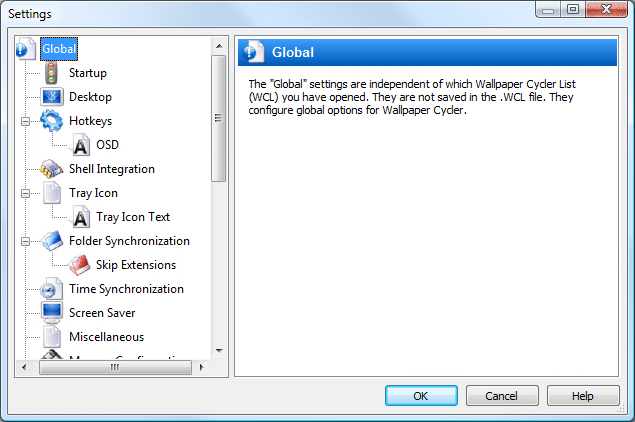
The tree on the left of this window contains several option categories. There are two main categories:
Global Settings
The global settings are independent of which Wallpaper Cycler List (WCL file) you have opened. They are not saved in the WCL file. The following global settings are available.
Startup
This section contains several settings regarding the startup behavior of Wallpaper Cycler.
- Auto-start Wallpaper Cycler at Windows logon:
When selected, Wallpaper Cycler will be loaded at Windows logon. If you do this, consider selecting the "Auto-start cycling"-option (see beneath) as well. This way you don't always have to start cycling manually. - Cycle once and exit at Windows logon:
When enabled, Wallpaper Cycler will be loaded at Windows logon. It will cycle the wallpaper once and Wallpaper Cycler will be terminated.
The same effect is achieved when you start Wallpaper Cycler with "-cycle_and_exit" as parameter. - Cycle once and do not exit at Windows logon:
Wallpaper Cycler will cycle once but will not exit when you login to Windows. Of course, when you enable the "Auto-start cycling when Wallpaper Cycler boots" option, Wallpaper Cycler will start cycling.
The same effect is achieved when you start Wallpaper Cycler with "-cycle_once_and_dont_exit" as parameter. - Cycle once every day and do not exit at Windows
logon:
Wallpaper Cycler will cycle once every day but will not exit when you login to Windows. Of course, when you enable the "Auto-start cycling" option, Wallpaper Cycler will start cycling. - Cycle once every day and exit at Windows logon:
Wallpaper Cycler will cycle once every day and will exit when you login to Windows. - Auto-start cycling when Wallpaper Cycler boots:
When selected, Wallpaper Cycler will automatically start cycling when booted. - Rerender current wallpaper when Wallpaper Cycler
starts:
When this is enabled, Wallpaper Cycler will rerender the current wallpaper on the desktop. This is useful to update for example a calendar object on your desktop. - Rerender on startup delay (seconds):
This option sets a delay in seconds for the above "Rerender current wallpaper when Wallpaper Cycler starts" option. - Delay load last WCL at startup (seconds):
The number of seconds that Wallpaper Cycler will wait before loading the last WCL file when it is starting up. This option can be used when Wallpaper Cycler is having trouble loading the WCL at startup of Windows, for example, when your WCL is located on a network share. In such a case it might be that the share is not yet available when Wallpaper Cycler starts. By specifying a delay, you give the system some time before Wallpaper Cycler tries to load the file.
Desktop
This section contains desktop-specific settings.
- Make text of icons on desktop transparent:
When you enable this option, the text of the icons on your desktop will be made transparent.
NOTE: On Windows XP, this option is not really required as Windows XP has built-in support for transparent text. You can enable this built-in transparency by following these steps:- Go to the Control Panel of Windows and open the "System" control panel.
- Select the "Advanced" tab.
- Click on the "Settings" button under the Performance heading.
- Find the option "Use drop shadows for icon labels on the desktop" and enable that option.
- Click "OK" and "OK".
- Hide desktop icons:
This option will hide all icons on your desktop, so they don't clutter your wallpaper. To quickly show/hide the desktop icons, you can also right click on the Wallpaper Cycler icon in the notification area (the icons next to the clock of Windows), click on "Desktop" and then on "Hide Desktop Icons". - Enable processing double clicks on desktop: (Not available in the Lite version)
When this option is enabled, Wallpaper Cycler will process double clicks on the desktop when you double click on objects that support double clicking. For example, you can double click on a day in a Calendar Notes Object to quickly add/modify the notes for that day. - Enable hand-cursor on desktop objects: (Not available in the Lite version)
When this option is enabled, Wallpaper Cycler will display a hand-cursor when you move your mouse over an object on the desktop on which you can (double) click to perform certain actions. Objects here mean objects rendered by a Wallpaper Cycler layout. For example, you can double click on a day in a Calendar Notes Object to quickly add/modify the notes for that day.
Hotkeys
The Hotkeys section allows you to configure system-wide hotkeys that can be used everywhere in Windows to manipulate Wallpaper Cycler. The following hotkeys are available:
- Show/Hide window hotkey:
Enables you to specify a system-wide shortcut for "Show/Hide Window". When you press this shortcut anywhere in Windows, the Wallpaper Cycler window will be shown/hidden. - Start cycling hotkey:
Enables you to specify a system-wide shortcut for "Start Cycling". When you press this shortcut anywhere in Windows, Wallpaper Cycler will start cycling wallpapers. - Stop cycling hotkey:
Enables you to specify a system-wide shortcut for "Stop Cycling". When you press this shortcut anywhere in Windows, Wallpaper Cycler will stop cycling wallpapers. - Next wallpaper hotkey:
Enables you to specify a system-wide shortcut for "Next Wallpaper". When you press this shortcut anywhere in Windows, Wallpaper Cycler will cycle to the next wallpaper. - Next wallpaper from same category hotkey:
Enables you to specify a system-wide shortcut for "Next Wallpaper From Same Category". When you press this shortcut anywhere in Windows, Wallpaper Cycler will cycle to the next wallpaper from the same category as the current wallpaper. - Previous wallpaper hotkey:
Enables you to specify a system-wide shortcut for "Previous Wallpaper". When you press this shortcut anywhere in Windows, Wallpaper Cycler will cycle back to the previous wallpaper. - No wallpaper hotkey:
Enables you to specify a system-wide shortcut for "No Wallpaper". When you press this shortcut anywhere in Windows, Wallpaper Cycler will reset the desktop background, so no wallpaper is visible. - Refresh current wallpaper hotkey:
Enables you to specify a system-wide shortcut for "Refresh Current Wallpaper". When you press this shortcut anywhere in Windows, Wallpaper Cycler will refresh the current wallpaper on your desktop. - Rerender current wallpaper hotkey:
Enables you to specify a system-wide shortcut for "Rerender Current Wallpaper". When you press this shortcut anywhere in Windows, Wallpaper Cycler will rerender the current wallpaper on the desktop. - Exit hokey:
Enables you to specify a system-wide shortcut for "Exit". When you press this shortcut anywhere in Windows, Wallpaper Cycler will exit. - Exit and restore hotkey:
Enables you to specify a system-wide shortcut for "Exit And Restore". When you press this shortcut anywhere in Windows, Wallpaper Cycler will exit and restore the desktop. - Notes editor hotkey: (Not
available in the Lite version)
Enables you to specify a system-wide shortcut for "Notes Editor". When you press this shortcut anywhere in Windows, the Wallpaper Cycler Notes Editor will be shown to quickly change notes. - Show feeds menu hotkey: (Not
available in the Lite version)
Enables you to specify a system-wide shortcut for "Show Feeds Menu". When you press this shortcut anywhere in Windows, a menu with all your RSS feeds will appear to quickly jump to a news item. This menu will also display the current news items on your desktop so you quickly access them. Learn more about news feeds. - Show calendar notes editor: (Not
available in the Lite version)
Enables you to specify a system-wide shortcut for "Show Calendar Notes Editor". When you press this shortcut anywhere in Windows, Wallpaper Cycler will open the calendar notes editor. - Show EXIF data of current wallpaper:
Enables you to specify a system-wide shortcut for "Show EXIF Data". When you press this shortcut anywhere in Windows, Wallpaper Cycler will show the EXIF data of the current wallpaper on your desktop. - Toggle desktop icons:
Enables you to specify a system-wide shortcut for "Toggle desktop icons". When you press this shortcut anywhere in Windows, Wallpaper Cycler will show/hide the icons on your desktop. - Open current wallpaper:
Enables you to specify a system-wide shortcut for "Open current wallpaper". When you press this shortcut anywhere in Windows, the current wallpaper on the desktop will be opened in the default image program on your system. - Open current wallpaper in Explorer:
Enables you to specify a system-wide shortcut for "Open current wallpaper in Explorer". When you press this shortcut anywhere in Windows, a Windows Explorer window will open with the current wallpaper on the desktop selected. - Remove current wallpaper from list and cycle:
Enables you to specify a system-wide shortcut for "Remove current wallpaper from list and cycle". When you press this shortcut anywhere in Windows, the current wallpaper on the desktop will be removed from the Wallpaper Cycler image list and Wallpaper Cycler will cycle to the next wallpaper. Wallpapers that are stored on your harddrive, will not be physically removed from the harddrive. - Delete current wallpaper and cycle:
Enables you to specify a system-wide shortcut for "Delete current wallpaper and cycle". When you press this shortcut anywhere in Windows, the current wallpaper on the desktop will be removed from the Wallpaper Cycler image list and Wallpaper Cycler will cycle to the next wallpaper. If the wallpaper is stored on your harddisk it will also be physically deleted from your harddisk. - Restore and stop cycling:
Enables you to specify a system-wide shortcut for "Restore and stop cycling". When you press this shortcut anywhere in Windows, Wallpaper Cycler will restore your desktop and will stop cycling. - Toggle slideshow mode:
Enables you to specify a system-wide shortcut for "Toggle slideshow mode". When you press this shortcut anywhere in Windows, Wallpaper Cycler will switch to slideshow mode in which the wallpaper on your desktop is cycled according to the slideshow mode settings. Learn more about the slideshow mode.
Click on the "Reset Hotkeys" button to clear all assigned hotkeys.
To clear one specific hotkey, first click on that hotkey in the list and then click on the rectangle that appears on the right (= the hotkey entry text box). To clear the hotkey, press the Esc (= Escape) key on your keyboard.
OSD
The OSD section allows you to setup an On Screen Display (OSD) that will be shown each time you press one of the system-wide hotkeys assigned above. The OSD will show which hotkey has been pressed, to give a graphical cue as to what is happening. There is a "Preview" button which you can click to get an idea of how your OSD will look like.
Shell Integration
When you enable the shell integration, there will be an extra menu item when you right click on a file in Windows Explorer. This extra menu item is called "Add To NuonSoft Wallpaper Cycler" and has the following little icon.
![]()
When you click that menu item a window similar to the following will appear.
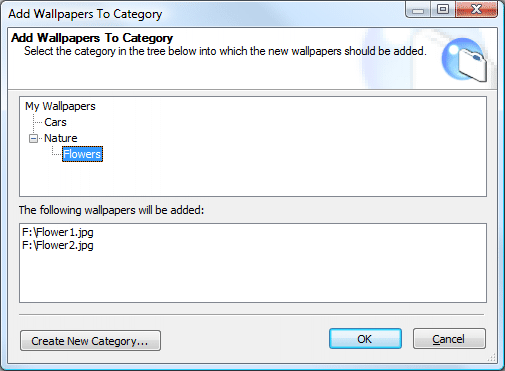
In the tree at the top of the window, you have to select the category into which you want the wallpapers to be imported. To create a new category, click the "Create New Category..." button at the lower left corner of the window.
The list at the bottom of the window shows all the wallpapers that will be added.
Notification Area Icon
This section allows you to change the behavior and look of the Wallpaper Cycler icon in the notification area (the icons next to the clock of Windows). Normally, when you right click the icon, a menu will be shown. When you left click the icon, the Wallpaper Cycler main window will be shown or hidden depending if it is currently hidden or shown respectively. If you enable the "Double click on icon cycles wallpaper" and you double click on the icon, Wallpaper Cycler will cycle the wallpaper on the desktop.
You can also change the icons that are used. Click on the "..." button to select any icon to use. If you leave these icon entries empty, the default icons will be used.
Icon Text
With the "Icon Text" section you can change the text that appears in the tooltip of the Wallpaper Cycler icon in the notification area.
All occurrences of %1 in the tooltips will be changed with the time until the next cycle happens. All occurrences of %2 will be changed with the name of the current wallpaper.
The tooltip texts can have a maximum of 64 characters or 128 characters depending on the version of your Windows shell. If you have an older version of Internet Explorer, you can't have multiline tooltips.
Folder Synchronization
The synchronization feature allows you to link certain folders on your hard disk with certain wallpaper categories. By doing so, the synchronization feature will be able to detect new wallpapers in that folder on your hard disk and will add these new wallpapers to the linked wallpaper category. Learn more about folder synhronization. The following options are available for this feature.
- Automatically synchronize folder links:
When this option is enabled, Wallpaper Cycler will automatically detect changes in the folders linked to your categories and will automatically synchronize them with a 10 second delay. NOTE: This delay is added to prevent Wallpaper Cycler from synchronizing constantly while you are copying new images to a linked folder. This delay does not mean that Wallpaper Cycler checks every 10 seconds for new wallpapers! Wallpaper Cycler will be notified by Windows when something changes in a linked folder. - Automatically save the list after a synchronization:
When this option is enabled, Wallpaper Cycler will automatically save the wallpaper list after a synchronization. This will only work when the wallpaper list has already been saved at least once so that it has a name. - Display synchronization result balloon:
When this option is enabled, Wallpaper Cycler will show a small balloon from the notification area with a summary of the synchronization results. You can click this balloon to get a more detailed description. The balloon looks like the following screenshot.

- Display ChangeNotification error messages:
When this option is enabled, Wallpaper Cycler will show ChangeNotification error messages when it fails to install a monitor on a certain folder. When you get a ChangeNotification error, it means Wallpaper Cycler will not be able to monitor that folder for new or changed files and folders.
Skip Extensions
This section allows you to specify which extensions are skipped when adding wallpapers to the list. For example, you can add db as extension to skip because that extension is used by the thumbnail files of Windows Explorer.
Click the "Reset to Defaults..." button to reset the list of skipped extensions to the factory default list.
Time Synchronization
Wallpaper Cycler can synchronize your Windows clock with a time server on the internet. The Time Synchronization settings allow you to configure this feature.
|
Note: The Time Synchronization option requires that Wallpaper Cycler is running with administrative privileges. When UAC (User Account Control) in Windows Vista is enabled, even if you are running with a user that belongs to the Administrators group, Wallpaper Cycler will not be running with administrative privileges and will not be able to change the time. If you want to use the Time Synchronization feature you will need to run Wallpaper Cycler by right clicking it in Windows Explorer and clicking on "Run as administrator". |
Screen Saver
(Not available in the Lite version)
Learn more about the screen saver module.
Miscellaneous
The "Miscellaneous" section contains the following settings:
- Always use XP-style menus:
When you enable this setting, the menus will always be drawn in the Windows XP style. When this setting is not set, the menus will be drawn according to your system settings. - Reset cycle-with-delay time on wallpaper change:
When you enable this option, the cycle-with-delay time will be reset each time the wallpaper is changed either manually or with a cycle-at-time. - Remember selected wallpaper per category:
If this option is enabled, Wallpaper Cycler will remember the selected wallpaper in each category. - Rerender wallpaper when display settings changed:
When this option is enabled, Wallpaper Cycler will automatically rerender the wallpaper when your display settings (resolution for example) change. - Cycle wallpaper when display settings changed:
When this option is enabled, Wallpaper Cycler will automatically cycle the wallpaper when your display settings (resolution for example) change. In combination with the Smart Orientation feature, this can be useful to automatically cycle the wallpaper when a tablet is being rotated. - Rerender wallpaper when resuming the computer:
When this option is enabled, Wallpaper Cycler will automatically rerender the wallpaper when you resume the computer from sleep or hibernate mode. This is done with a 10 second delay. - Do not cycle during screensaving or Fast User
Switching:
Enable this option to prevent Wallpaper Cycler from cycling the wallpaper when a screen saver is running or when you have locked your desktop. - Auto prune calendar notes: (Not
available in the Lite version)
Enable this option to automatically delete calendar notes from the past. - Auto prune days before today: (Not
available in the Lite version)
Specify the number of days before today to start pruning. For example: if you set this to 2, all calendar notes from earlier than 2 days before today are pruned. If you set this to 0, all notes from before today are pruned. - Program for "Open Image With":
Specify the program that Wallpaper Cycler should run when you right click on an image and choose "Open Image With..." in the main window of Wallpaper Cycler. - Show wizard when opening main window:
When this is enabled, a wizard will be shown when you open the main window of Wallpaper Cycler to guide you through the most important tasks. - Render desktop to folder:
Specify the folder where you want Wallpaper Cycler to store its rendered image (NuonSoft WPC Wallpaper.bmp). Leave this empty to let Wallpaper Cycler store the bitmap in your roaming application data folder, which on Vista is something like "C:\Users\<username>\AppData\Roaming\NuonSoft\WallpaperCycler". - Use the online web-based help:
When this option is enabled, Wallpaper Cycler will use the online web-based help system. When this option is disabled, Wallpaper Cycler will use the offline help. - Show help text in image preview:
When this option is enabled, a small help text will be shown when previewing an image. An image can be previewed by pressing the spacebar when an image is selected in the main window of Wallpaper Cycler. Learn more about the fullscreen preview. - My Wallpapers requires double click to show wallpapers: When this option is enabled and you click on the My Wallpapers category, the wallpapers will not immediately be shown. They will be shown after double clicking a message. It is recommended to enable this option when working with large lists.
- Automatically highlight new wallpaper after cycling: When this option is enabled, Wallpaper Cycler will automatically highlight the new wallpaper in the main window when cycling to the next or previous wallpaper.
- Use high quality scaling in fullscreen preview: When this option is enabled, Wallpaper Cycler will use the same high quality scaling algorithm in the fullscreen preview as is being used to actually render the desktop. On slower systems, this might slow down the fullscreen preview.
- Show news feed download error balloon: When this option is enabled, Wallpaper Cycler will show an error balloon when something went wrong during the download of a news feed. (Not available in the Lite version)
- Render N/A on feed error: When this option is enabled, Wallpaper Cycler will render the text n/a on the desktop when something went wrong to display a news feed. When this is disabled, no text will be rendered in case of an error. (Not available in the Lite version)
Manage Configuration
This section allows you to manage the Wallpaper Cycler settings. There are three things you can do.
- Export: Export all Wallpaper Cycler settings to a user specified file.
- Import: Import a previously exported Wallpaper Cycler settings file.
- Defaults: Restore all Wallpaper Cycler settings to their default values.
|
Note: The Wallpaper Cycler settings managed by the above options do not include the Wallpaper Cycler List options which are saved inside the .WCL file. The Wallpaper Cycler List options can be changed with "File > Document Settings > Document". |
Repair
This section allows you to repair certain configuration problems.
- Reset Tiling Settings: Wallpaper Cycler will change some tiling-offset settings of Windows to support multi-monitor wallpapers. If you want to reset these changes, click the button on the left.
- Fix Associations: When you double click on a .WCL file, it is opened with Wallpaper Cycler. If this doesn't work anymore, you could try to repair the associations.
Document Settings
The document settings are specific for the currently loaded Wallpaper Cycler List (WCL file) and are saved in the WCL file. The following document settings are available.
Wallpaper Cycling
This section allows you to change how Wallpaper Cycler should cycle.
Use "Cycle with the following delay between wallpapers" if you want Wallpaper Cycler to change the wallpaper with the specified interval.
Use "Cycle at specific times (24 hour format)" if you want Wallpaper Cycler to change the wallpaper at a specific time. Use the "Add", "Edit" and "Remove" button to add a new time, edit the currently selected time or remove the currently selected time respectively from the list. You can also use the "Add" button to automatically generate a timestamp every x minutes.
The "Wallpaper Cycling" section also allows you to change how Wallpaper Cycler will choose the next wallpaper. There are two options:
- Choose random wallpaper when cycling: Wallpaper Cycler will choose a random wallpaper from the enabled wallpaper categories.
- Cycle wallpaper sequentially: Wallpaper Cycler will cycle all your wallpaper in a sequential manner.
The "Post cycling script" allows you to specify a Windows Scripting file that will be executed when Wallpaper Cycler cycles the wallpaper. This can for example be a JScript or VBScript file. The one and only parameter to this script is the name of the file to which Wallpaper Cycler has rendered the desktop.
As an example a "Microsoft Powerdesk Powertool.js" script is installed in the "Post Cycling Scripts" subfolder of the Wallpaper Cycler installation folder. This script makes sure that when Wallpaper Cycler changes the wallpaper that it will be changed on all desktops of the MS Powerdesk Powertool. This example script can be seen below:
////////////////////////////////////////////////////////////////
//
// This WSH file can be used by NuonSoft Wallpaper Cycler as
// a "Post Cycling Command" to make Wallpaper Cycler compatible
// with the Microsoft Powerdesk Powertoy (multiple desktops).
// When this WSH is configured as a Post Cycling Command
// Wallpaper Cycler will change the wallpaper on all desktops.
//
// The first parameter to this script is the name of the
// rendered desktop that Wallpaper Cycler created.
//
////////////////////////////////////////////////////////////////
var args = WScript.Arguments;
var fso = WScript.CreateObject("Scripting.FileSystemObject");
var TemporaryFolder=2;
var tempfolder = fso.GetSpecialFolder(TemporaryFolder);
if (args.length != 1)
{
WScript.Echo("Missing parameter");
}
else
{
// MS Powerdesk Powertool stores its wallpapers in the temp folder
// with MSVDM-DesktopX.bmp as name where X=0...3
for (i=0; i<4; i++)
fso.CopyFile(args(0), tempfolder + "\\" + "MSVDM-Desktop" + i + ".bmp");
}
|
This script will copy the rendered image which is in args(0) to "<tempfolder>\MSVDM-DesktopX.bmp" (X=0,1,2,3) which is required by the MS Powerdesk Powertool.
Slideshow Mode
On this page you can configure a timeout that Wallpaper Cycler will use when it is in Slideshow Mode. Learn more about the slideshow mode.
Timed Refresh
The "Timed Refresh" feature allows you to rerender the wallpaper with the specified interval. This is useful if you only cycle your wallpapers once every day, but you have a webcam object on your wallpaper that you want to refresh every hour.
Layout Cycling
(Not available in the Lite version)
Change how Wallpaper Cycler cycles the different layouts. There are several possibilities:
- Do not use layouts: Wallpaper Cycler will not use any layouts, and will simply show the wallpaper on each monitor.
- Choose layout sequentially: Wallpaper Cycler will cycle the layouts in a sequential manner.
- Choose random layout: Wallpaper Cycler will choose a new random layout each time Wallpaper Cycler cycles the wallpaper.
- Always use the following layout: Wallpaper Cycler will always use the selected layout for rendering the wallpaper.
The above settings are the general layout cycling settings. To each wallpaper and wallpaper category you can assign layouts and/or layout-categories. See the layout setting in the category window and the layout setting in the Info Panel for wallpapers. When Wallpaper Cycler cycles to a specific wallpaper, it follows a specific work flow to determine the layout to use. Learn more about this work flow.
Cycling Sound
This section allows you to change the sound that is played whenever Wallpaper Cycler changes the wallpaper on the desktop. Use the "..." button to browse for a specific .wav file that you want to use or leave the text entry empty to use the default sound. Click on the "Play" button to play the selected sound.
CPU Monitoring
Wallpaper Cycler has a built-in CPU load monitoring feature. This feature can be used to prevent Wallpaper Cycler from cycling when your CPU load is too high. When CPU load monitoring is enabled, Wallpaper Cycler will average the load of your CPU in the 10 second before cycling. When this average CPU load in this 10 seconds is above a certain threshold, Wallpaper Cycler will not cycle the wallpaper. The threshold is specified in percentage.
You can also let Wallpaper Cycler play a sound whenever the CPU load was too high to cycle. Use the "..." button to browse for a specific .wav file that you want to use or leave the text entry empty to use the default sound. Click on the "Play" button to play the selected sound.
|
Note: This CPU load monitoring only works on Windows NT/2000/XP or later. Note: The CPU Monitoring option requires that Wallpaper Cycler is running with administrative privileges. When UAC (User Account Control) in Windows Vista is enabled, even if you are running with a user that belongs to the Administrators group, Wallpaper Cycler will not be running with administrative privileges and will not be able to query the CPU state. If you want to use the CPU Monitoring feature you will need to run Wallpaper Cycler by right clicking it in Windows Explorer and clicking on "Run as administrator". |
Text Color Settings
This section allows you to change the settings for the desktop background color and the desktop icons text color.
For each wallpaper you can specify a specific background color and/or text color or you can choose "Automatic". See wallpaper settings. If you choose automatic, you can use this "Text Color Settings" section to specify how Wallpaper Cycler should interpret this "Automatic" setting. There are two options:
- Wallpaper Cycler icon in the notification area background and text color based on image: If you enable this option, Wallpaper Cycler will calculate the background and text color of the desktop automatically. This calculation is based on the current wallpaper and on the current icons and position of icons on your desktop.
- Always use the following background color and text color: If you enable this option, Wallpaper Cycler will always use the selected background and text color.
NOTE: Windows XP has by default transparent icons and puts a nice shadow around the white text to make it better readable. Because of this you cannot change the text color of the icons with Wallpaper Cycler. If you still wish to change the text color of the icons, you have to disable the shadow around the icons as follows:
- Go to the Control Panel of Windows and open the "System" control panel.
- Select the "Advanced" tab.
- Click on the "Settings" button under the Performance heading.
- Find the option "Use drop shadows for icon labels on the desktop" and disable that option.
- Click "OK" and "OK".
When you disable the shadows of the text on the desktop on Windows XP, the icons won't be transparent anymore, but you can use the Wallpaper Cycler desktop settings to change this.
Wallpaper Default Settings
The "Default tiling" option allows you to change the default tilling setting for all wallpapers that have the tiling set to "default".
The "Layout" section allows you to change the layout setting that will be applied when importing new wallpapers.
It also has an option to enable or disable the auto generation of tags like "AspectRatio x:y". When this option is enabled, Wallpaper Cycler will automatically assign a tag like "AspectRatio 4:3" where the 4:3 is automatically calculated based on the added wallpaper or "AspectRatio Uneven". Enable the option "Only generate sensible aspect ratios" to prevent generation of tags like "Aspect Ratio 123:36". If that option is enabled only aspect ratio tags with components <= 16 will be generated, for example "Aspect Ratio 16:9", "Aspect Ratio 5:3"...
You can also specify a default tag that will automatically be assigned to all new wallpapers. By default this is set to "To Be Reviewed". This makes it easy to use a search folder to find all wallpapers with the "To Be Reviewed" tag so that you can quickly review the tags assigned to those wallpapers.
Screen Saver
(Not available in the Lite version)
Learn more about the screen saver module.
"Move To" Hotkeys
The "Move To" Hotkeys allow you to configure system-wide hotkeys to quickly move the current wallpaper on your desktop OR the selected wallpaper in Wallpaper Cycler to a specific category. A hotkey can also be configured to show a menu of all available categories.
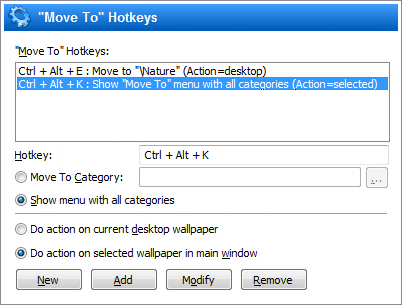
A list at the top of this window shows all "Move To" Hotkeys that have been defined.
Click the "New" button to start a new hotkey. In the "Hotkey" textbox you can press the hotkey that you want on your keyboard. After configuring the hotkey and the action for that hotkey you have to press the "Add" button. A hotkey can do one of two things:
- Move To Category: Click the "..." button to select a specific category. When this hotkey is pressed anywhere in Windows, the current wallpaper on your desktop OR the selected wallpaper in Wallpaper Cycler is moved to this selected category.
- Show menu with all categories: When you enable this for your hotkey and you press this hotkey anywhere in Windows, a menu will be shown that shows all your wallpaper categories. You can select any of these categories to move the current wallpaper on your desktop OR the selected wallpaper in Wallpaper Cycler to that category. At the top of this menu is a small preview of the wallpaper that you are going to move (only with "Do action on current desktop wallpaper"). This menu looks like in the following screenshot:
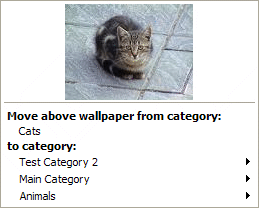
Note: With "Do action on current desktop wallpaper" and if you are using layouts, only the wallpaper that is called "Auto" will be moved to this category. If you have secondary wallpaper objects on your layout, these wallpapers will not be moved!
You can click any of the defined hotkeys in the list at the top of the window to change its settings. After making your changes to a hotkey you have to click the "Modify" button to save your changes for that hotkey.
Remove a hotkey by selecting it in the list and clicking the "Remove" button.
"Quick Disable" Hotkeys
The "Quick Disable" Hotkeys allow you to configure system-wide hotkeys to quickly disable a category or tags. A hotkey can also be configured to show a menu of all available categories or all available tags. When you disable a category with this feature and a wallpaper on your desktop is from this disabled category, Wallpaper Cycler will automatically cycle to the next wallpaper. When a tag is disabled with a hotkey and a wallpaper on the desktop has that tag, the desktop will be cycled automatically. Wallpapers with disabled tags will not be cycled.
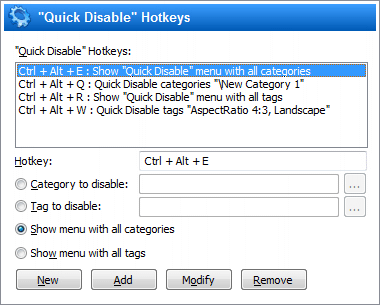
A list at the top of this window shows all "Quick Disable" Hotkeys that have been defined.
Click the "New" button to start a new hotkey. In the "Hotkey" textbox you can press the hotkey that you want on your keyboard. After configuring the hotkey and the action for that hotkey you have to press the "Add" button. A hotkey can do one of four things:
- Category to disable: Click the "..." button to select a specific category. When this hotkey is pressed anywhere in Windows, the selected category will be disabled.
- Tag to disable: Click the "..." button to select specific tags. When this hotkey is pressed anywhere in Windows, the selected tags will be disabled. This can be used to quickly disable all wallpapers matching a certain tag. Wallpapers with disabled tags will not be cycled.
- Show menu with all categories: When you enable this for your hotkey and you press this hotkey anywhere in Windows, a menu will be shown that shows all your wallpaper categories. You can select any of these categories to quickly disable it. At the top of this menu is a small preview of the current wallpaper. This menu looks like in the following screenshot:

- Show menu with all tags: When you enable this for your hotkey and you press this hotkey anywhere in Windows, a menu will be shown that shows all your tags. You can use this menu to quickly enable or disable tags. Wallpapers with disabled tags will not be cycled. This menu looks like in the following screenshot:
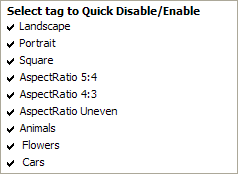
You can click any of the defined hotkeys in the list at the top of the window to change its settings. After making your changes to a hotkey you have to click the "Modify" button to save your changes for that hotkey.
Remove a hotkey by selecting it in the list and clicking the "Remove" button.
"Give Tags" Hotkeys
(Not available in the Lite version)
The "Give Tags" Hotkeys allow you to configure system-wide hotkeys to quickly add tags to the current wallpaper on your desktop OR to the selected wallpaper in Wallpaper Cycler. A hotkey can also be configured to show a menu of all available tags to quickly add and remove tags from the current wallpaper OR the selected wallpaper in Wallpaper Cycler.
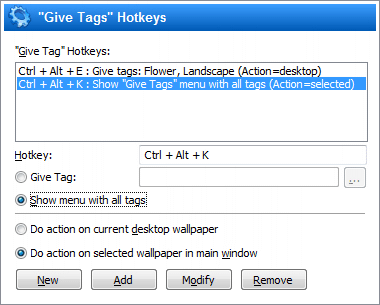
A list at the top of this window shows all "Give Tags" Hotkeys that have been defined.
Click the "New" button to start a new hotkey. In the "Hotkey" textbox you can press the hotkey that you want on your keyboard. After configuring the hotkey and the action for that hotkey you have to press the "Add" button. A hotkey can do one of two things:
- Give Tag: Click the "..." button to select specific tags. When this hotkey is pressed anywhere in Windows, the selected tags will be added to the current wallpaper on your desktop OR the selected wallpaper in Wallpaper Cycler.
- Show menu with all tags: When you enable this for your hotkey and you press this hotkey anywhere in Windows, a menu will be shown that shows all your tags. When "Do action on current desktop wallpaper" is enabled, you can use this menu to quickly add or remove tags from the current wallpaper on your desktop. When "Do action on selected wallpaper in main window" is enabled, you can use this menu to quickly add tags to the selected wallpaper in Wallpaper Cycler. When "Do action on current desktop wallpaper" is enabled, the menu will show a small preview of the wallpaper for which you are changing tags. This menu looks like in the following screenshot:
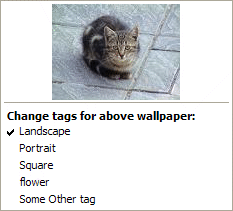
Note: With "Do action on current desktop wallpaper" and if you are using layouts, only tags for the wallpaper that is called "Auto" will be changed. If you have secondary wallpaper objects on your layout, tags for these wallpapers will not be changed!
You can click any of the defined hotkeys in the list at the top of the window to change its settings. After making your changes to a hotkey you have to click the "Modify" button to save your changes for that hotkey.
Remove a hotkey by selecting it in the list and clicking the "Remove" button.
Smart Orientation
(Not available in the Lite version)
The Smart Orientation feature is meant to make it easier to render appropriate wallpapers on your desktop depending on the orientation of your primary monitor. This is useful when you have a pivotting monitor or when you use a tablet PC.
Learn more about the Smart Orientation feature.
|
Copyright © 2009 NuonSoft |